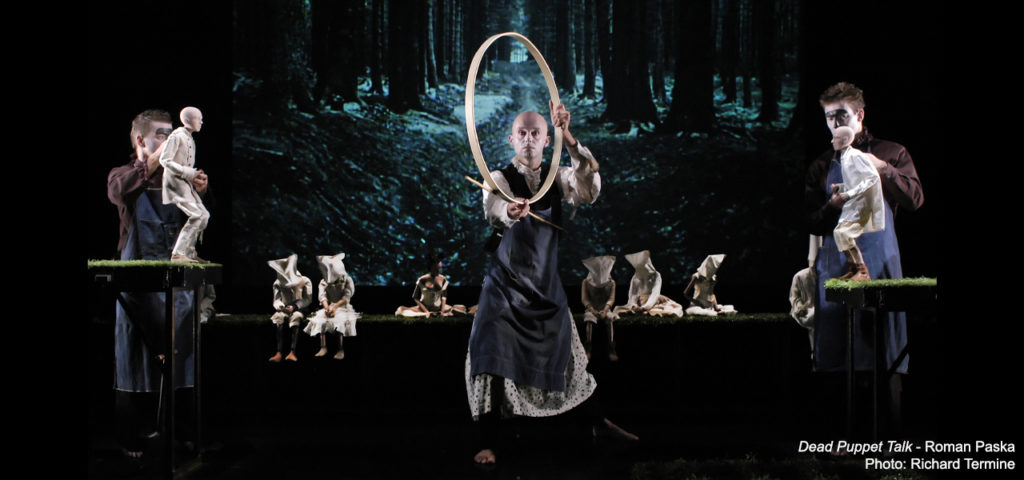
2004
PROJECT GRANTS ($5,000)
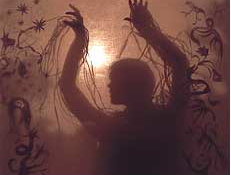
Little Words
by Chris Green
Photo by Matthew Acheson
Ping Chong and Company (New York, NY)
BLIND NESS: The Irresistible Light of Encounter is a multidisciplinary work exploring the tragic history of the Belgian rule of the Congo and its continuing reverberations. Inspired by Joseph Conrad’s Heart of Darkness, contemporary literature on colonialism, and primary research in Belgium, BLIND NESS will incorporate shadow puppetry, bunraku puppetry, object theater, and live performance.
Chris Green (Brooklyn, NY)
Luboslovieh and Other Precious Little Words uses puppetry, dance, a tuba trio, and a Balkan duet to tell the story of a retired star gladiatrix in a Black Sea suburb, the spoiled son of a Soviet diplomat, and the unfurling of the gladiatrix’s illustrious past through their unlikely friendship, set within a kaleidoscopic mix of Bulgaria’s modern and ancient epochs.
Tom Lee (Brooklyn, NY)
Hoplite Diary is a large scale puppet work incorporating shadow, video animation, modified bunraku style puppets and stage machinery. It follows the journey of a hoplite (Greek footsoldier) through the Trojan War in a series of dreamlike and lyrical episodes. Original music will be created on the Ukrainian bandura and Russian gusli, instruments of Eastern European epic storytelling.
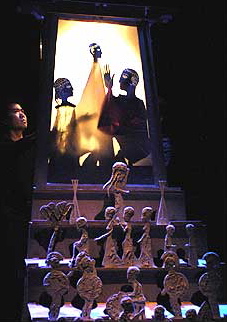
by Tom Lee
Photo by Richard Termine
LOCO 7 (New York, NY)
Yurupary, based on the heroic poem from the Colombian and Brazilian Amazon, tells of the age-old struggle for power between men and women and the conflict between the matriarchal and the patriarchal systerms. The piece will feature life size puppets and larger than life marionettes representing different characters such as the gods, shamans, tribal people, animals, and trees.
Mum Puppettheatre (Philadelphia, PA)
The Visit is a new translation and vision of Friedrich Durrenmatt’s play about a wealthy woman’s return to the town of her birth and the repellent bargain she offers the struggling townspeople. The piece will meld a tragicomic post-war German script with elements of traditional classical Japanese theater and contemporary Japanese manga culture, along with bunraku, hand, and shadow puppetry.
Eric Novak (Brooklyn, NY)
The Bacon/Mingus Triptych is composed of three short pieces inspired by the paintings of Francis Bacon and the music of Charles Mingus. Themes of art, violence and sex are found in both artists’ work and are represented through the deconstruction of the puppets as an abstract painting brought to life. Each section uses a combination of shadow puppetry and a modified bunraku style.

by Erin K. Orr
Photo by Cris Green
Erin K. Orr (Brooklyn, NY)
The Savage Nursery explores how identity is shaped and revealed by hunger, cruelty, loneliness, and resilience in the face of lost love. Told through live music, shadows, bunraku-style, rod, and hand puppetry, it is the mysterious fairy tale of a bird-woman raising her young fledgling birds, her lone defiant brattling, and the pack of feral children who collect at the foot of her nursery.
Roman Paska (New York, NY)
Dead Puppet Talk is a talking opera in which the rhythmic play of language creates a context for reflection about the nature of puppet theater. Faced with mortality, a puppeteer considers his life and finds himself struggling with the fundamental paradox of the puppet. How can we watch a puppet suffering? Do we see a living thing? Are our puppets victims? What do they have to say?
Redmoon Theater (Chicago, IL)
Cyrano is a collaboration with the Court Theatre to present an adaptation of Cyrano de Bergerac that combines Redmoon’s sophistication with puppetry and mechanical objects with the Court’s experience with classical text and actor based theater. This tale of the relationship between the literary and the physical, word and image will unfold through the interplay of puppets and live actors.
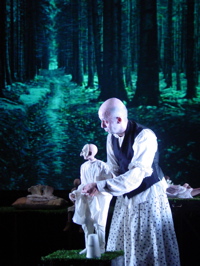
by Roman Paska
Photo by Airan Berg
Jane Catherine Shaw (Brooklyn, NY)
Universe Expanding explores concepts of space and time, as explained by science, myth, religion, and philosophy. A variety of puppet styles will be combined with other media, such as film, video, and dance to engage the audience in this intriguing subject. Original music composed by the renowned Rinde Eckert will propel the audience and performers through a series of vignettes.
Lake Simons (Brooklyn, NY)
Alice in Wonderland is an adaptation of Lewis Carroll’s classic told through bunraku, shadow, hand, and object puppetry, and physical storytelling such as pantomime. The live original score will act as the main source of dialogue, and the puppeteers will manipulate the story and the stage, literally changing the space as Alice travels and encounters the various characters in the story.
The Talking Band (New York, NY)
The Parrot, with book and lyrics by Paul Zimet, music by Ellen Maddow, and puppet and mask design by Ralph Lee, is a music-theater work for multi-generational audiences inspired by an Italian folk tale. The structure consists of a constantly unfolding story within a story in which a city girl decides that she doesn’t really need a prince after all.
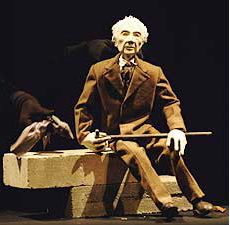
by Amanda Maddock
Photo by Richard Termine
Susan J. Vitucci (New York, NY)
Small Fish follows the odyssey of Phoebe, a sardine who becomes separated from her shoal. On her journey, the characters she meets help her to find the shoal and come to an understanding of her place in the world. Techniques will include hand, rod, and shadow puppets made primarily of common objects such as clothespins, sculpt styrofoam, felt, and map tacks.
Paul Zaloom (West Hollywood, CA)
Attack of the Giant Nose features both a shadow puppet show (semi-traditional and non-traditional puppets operated from behind) and a mixed media puppet piece (a combination of puppets, paintings, photos, objects, and trash on a table top stage). The topic is the relationship between events in American history, current events, and the artist’s oddball identity and life.
SEED GRANTS ($2,000)

by Perry Alley Theater
Photo by Bonnie Periale
Ronald Binion (Brooklyn, NY)
Searchpoint is a table-top style puppet show illustrating the daily prejudices and organizational pitfalls found in the behavior of supervisors and managers in a corporate environment. The first half of the piece depicts characters working and interacting in an office, and the second describes the evolution of the human brain and its propensity toward territoriality and social hierarchy.
The Brewery Troupe (Freeport, NY)
Blood on the Fields is a full scale puppet production of Wynton Marsalis’ Pulitzer Prize-winning jazz opera. This interpretation of jazz through puppetry tells of two Africans of different backgrounds who are kidnapped, brought to the United States, and made slaves in the nineteenth century. The puppets will be designed in a range of sizes and styles to reflect their various circumstances.
Glenn Brown (Salt Lake City, UT)
The Monster Spider is a play inspired by Japanese legends and told using bunraku style puppets, rod puppets, shadow puppets, Joruri chanters, Noh dancers, and live actors. The piece tells the story of a noble prince suffering from a mysterious disease, the beautiful courtesan who arrives to help him, and the prince’s discovery that she is actually a spider in disguise who has bewitched him.
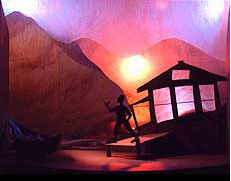
Sunday & Mermaid
by Alva Rogers
Photo by Richard Termine
Janie Geiser (Los Angeles, CA)
Invisible Glass is a puppet theater work inspired by Edgar Allen Poe’s short story William Wilson, incorporating actors, mechanical set elements, a variety of puppetry forms, shadows and projection, and original music to create an atmospheric world of escalating tension, where appearances are deceiving and no one can be certain of anything.
Bill Hubner (New York, NY)
Forgotten Dreams uses full body and hand puppets to present the tale ofa small village’s campaign to expel a hermit who lives on the outskirts of town. Unbeknownst to the townspeople, the hermit is the keeper of lost childhood dreams, gathering them lovingly in an old sack. Once the truth is revealed, they realize that the sack holds a treasure that they, as adults, can never reclaim.
Karen Kandel (New York, NY)
Portraits is an intimate journey into the lives of a family of women. Their stories are told, abstractly, using object theater techniques, text and music that will be specifically created for each woman. The set is an installation encompassing many small installations, encompassing even smaller installations. Video cameras in these hidden places will expose all secrets.
Brian Kooser (Seattle, WA)
Dracula: A Case Study is told from the point of view of the asylum inmates who figure so strongly in Bram Stoker’s classic novel. The inmates are using bunraku and shadow puppets as therapy to explore the events that led to their madness. As the story progresses through the stops and starts of insanity, a mystery unfolds. Was Dracula actually innocent?
The Lucidity Suitcase Intercontinental (Brooklyn, NY)
Planchar uses found objects, shadow puppets, toy cars, planes, boats, water and a box made of venetian blinds to create a cinematic adventure that takes place in many locations in Latin America. Stories from Pablo Escobar’s life and family are performed as a Latin American soap opera, with the family played by actors who also serve as puppeteers.
Amanda Maddock (Brooklyn, NY)
Mrs. Wright’s Escape explores the life of Olgivanna Wright, who lived for almost thirty years after her husband, world renowned architect Frank Lloyd Wright. The show contains scenes of Mrs. Wright in her bed as she tries to write, her metaphorical dreams, and flashbacks of events revolving around her famous husband and his artistic, architectural pursuits.
Cathy McCullough (Harrison, NY)
Orphan Train is based on the real life accounts of the orphan train riders. Between 1854 and 1929, orphan trains were responsible for the relocation of between 150,000 and 400,000 abandoned children from New York to towns across the United States. This fictional account of their struggles will be told using a variety of puppet styles and visible manipulators who will also be characters.
Rebecca McNulty (Waltham, MA)
Star Chronicler’s Journey is an intimate production designed for three visible puppeteers and one musician. The puppets will include thirteen carved basswood tabletop puppets, one marionette, and a number of direct screen shadow puppets. The puppeteers will act as storytellers, puppeteers and masked actors to recount the Chinese myth of the Star Chronicler, a Taoist sage and astronomer.
Perry Alley Theater (Strafford, NH)
Fish Faust is a dark comedy about relationships utilizing puppets, figures, and objects. Charlemagne Fist would give anything to have his late wife back, even his soul. A mephistophelian deliveryman brings her back, reincarnated in the body of a latex, singing fish. Together again, Fist’s desk becomes the stage upon which they attempt to work through the unresolved issues of their marriage.
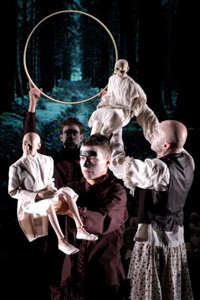
by Roman Paska
Photo by Richard Termine
Alva Rogers (Brooklyn, NY)
The Carolina Plays: Sunday & Mermaid is an evening of two one-act musicals adapted from folk tales and set on the South Carolina sea islands. The plays draw on the fantastical and demonstrate the power of nature to give essential gifts and to take life. Puppets and projected animations will be used to represent the natural worlds of both plays, especially birds and the many forms of marine life.
San Diego Guild of Puppetry (Chula Vista, CA)
Goldilocks, The Nursing Home Version depicts Goldilocks, a tiny Alzheimers’ afflicted 90 year old, forever lost in the care unit of The Woods, a nursing home with an inviting exterior but the inner charm of a wolf’s lair. Her nightly wanderings take her into the Three Bears room where she eats their food, pockets a pair of their false teeth, and settles herself into one of their empty beds.
Toni Schlesinger (New York, NY)
Dinner at 8:30 is a theater work with live performers, puppets, and musicians, featuring sets and puppets designed by New Yorker Magazine illustrator Tom Bachtell. It tells the story of a playwright who is tormented by her characters. In an effort to rid herself of them, she invites them to a “last supper” where seduction, intrigue, mayhem and murder ensue.
Cameron Wilson (Brooklyn, NY)
Safe as Houses combines puppets, shadows, performers and live music to draw from the Greek myth of Pandora’s box and Michail Lermontov’s poem The Demon. The themes of safety versus freedom and women’s mutual repression in modern society are explored through the adolescent Pandora (a physicalized Pandora’s box) and the old woman Tamara (handicapped by old age and regret).
PRESENTER’S GRANTS
Arts at St. Ann’s
– Papier Mache’ Cathedral – Bread and Puppet
Asheville Puppetry Alliance
– Puppets on the Ridge Festival
California Institute of the Arts
– The Art of Moving Objects series by REDCAT
The Culture Project
Puppetry Mini-Festival: Voice 4 Vision
– The Lone Runner: The Mythical Life and Journey of Nikola Tesla – Jane Catherine Shaw
– Project B – 3 Works – Nancy Solomon Miranda, Sarah Provost and Jane Stein
– The Bacon/Mingus Triptych – Eric Novak
– Loners – Preston Foerder
HERE Arts Center
– What’s Inside An Egg? – Lake Simons
– Animal – Kevin Augustine
– Mon Oeil – Aie Aie Aie (France)
La MaMa E.T.C.
– Transposition – Ishara Puppet Theater (India)
– And I Have Uncurtained the Night – Opole Puppet Theatre (Poland)
– The 47th Street Hotel – Rick Ebihara
– Caliban Remembers: A Balinese Tempest – I Nyoman Catra
– The Legend of the Forest – Noriyuki Sawa (Japan)
– Hoplite Diary – Tom Lee
– The Last Escape – Wroclaw National Puppet Theatre (Poland)
– Bokan, The Bad Hearted – Loco7 Theatre Company
PS122
– Hamlet – Tiny Ninja Theater
The Cathedral Church of St. John the Divine
– The Heroic and Pathetic Escapades of Karagiozis – Mettawee River Theatre Company
Japan Society
– Dogugaeshi – Basil Twist
The Kitchen
– Dead Puppet Talk – Roman Paska
– The Happy Prince – Amy Trompetter
New England Presenters/Arts Presenters of Northern New England
– The Savage Nursery – Erin Eagar Orr
The New Victory Theater
– Kikker – Theater Terra (The Netherlands)
“Lyubo was a personal milestone. In some ways, it was a gleaning of over five years worth of my own experimentation and work. In other ways, it was a risky endeavor drawn from elusive scratch. The Henson grant allowed a level of endurance and passion to come forth that I think made the piece as successful as it was. As valuable as anything else, the grant provided moral support for us in a field that is incredibly under-funded. As puppeteers, we have a ravenous appetite for our work, but the strictures of urban life mean that, no matter how passionate we are, funding is going to be an issue. Having a sense of support from an organization that intimately understands the field is humbling and not to be taken for granted.”
– Chris Green
“For inveterate puppet people the Henson Foundation is not a foundation in the abstract, it is Their foundation, Our foundation, the One foundation for whom the prickly P-word is a password and not an impediment, the foundation with (ironically?) the most human face. With the Foundation’s blessing, artists of every stripe have entered the puppet fold, and the practice of puppetry flourished in a myriad of disciplines. Without it (Our One Special Foundation), puppet life would be neither what nor where it is today.”
– Roman Paska